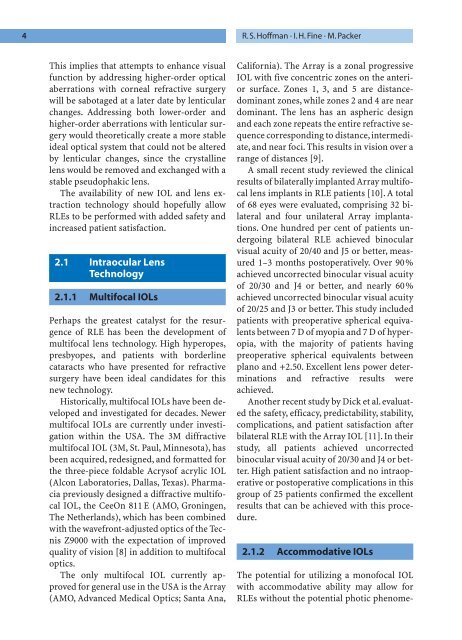Refractive Lens Surgery
Refractive Lens Surgery
Refractive Lens Surgery
Create successful ePaper yourself
Turn your PDF publications into a flip-book with our unique Google optimized e-Paper software.
4 R.S. Hoffman · I.H. Fine · M. Packer<br />
This implies that attempts to enhance visual<br />
function by addressing higher-order optical<br />
aberrations with corneal refractive surgery<br />
will be sabotaged at a later date by lenticular<br />
changes. Addressing both lower-order and<br />
higher-order aberrations with lenticular surgery<br />
would theoretically create a more stable<br />
ideal optical system that could not be altered<br />
by lenticular changes, since the crystalline<br />
lens would be removed and exchanged with a<br />
stable pseudophakic lens.<br />
The availability of new IOL and lens extraction<br />
technology should hopefully allow<br />
RLEs to be performed with added safety and<br />
increased patient satisfaction.<br />
2.1 Intraocular <strong>Lens</strong><br />
Technology<br />
2.1.1 Multifocal IOLs<br />
Perhaps the greatest catalyst for the resurgence<br />
of RLE has been the development of<br />
multifocal lens technology. High hyperopes,<br />
presbyopes, and patients with borderline<br />
cataracts who have presented for refractive<br />
surgery have been ideal candidates for this<br />
new technology.<br />
Historically, multifocal IOLs have been developed<br />
and investigated for decades. Newer<br />
multifocal IOLs are currently under investigation<br />
within the USA. The 3M diffractive<br />
multifocal IOL (3M, St. Paul, Minnesota), has<br />
been acquired, redesigned, and formatted for<br />
the three-piece foldable Acrysof acrylic IOL<br />
(Alcon Laboratories, Dallas, Texas). Pharmacia<br />
previously designed a diffractive multifocal<br />
IOL, the CeeOn 811 E (AMO, Groningen,<br />
The Netherlands), which has been combined<br />
with the wavefront-adjusted optics of the Tecnis<br />
Z9000 with the expectation of improved<br />
quality of vision [8] in addition to multifocal<br />
optics.<br />
The only multifocal IOL currently approved<br />
for general use in the USA is the Array<br />
(AMO, Advanced Medical Optics; Santa Ana,<br />
California). The Array is a zonal progressive<br />
IOL with five concentric zones on the anterior<br />
surface. Zones 1, 3, and 5 are distancedominant<br />
zones, while zones 2 and 4 are near<br />
dominant. The lens has an aspheric design<br />
and each zone repeats the entire refractive sequence<br />
corresponding to distance,intermediate,<br />
and near foci. This results in vision over a<br />
range of distances [9].<br />
A small recent study reviewed the clinical<br />
results of bilaterally implanted Array multifocal<br />
lens implants in RLE patients [10]. A total<br />
of 68 eyes were evaluated, comprising 32 bilateral<br />
and four unilateral Array implantations.<br />
One hundred per cent of patients undergoing<br />
bilateral RLE achieved binocular<br />
visual acuity of 20/40 and J5 or better, measured<br />
1–3 months postoperatively. Over 90%<br />
achieved uncorrected binocular visual acuity<br />
of 20/30 and J4 or better, and nearly 60%<br />
achieved uncorrected binocular visual acuity<br />
of 20/25 and J3 or better. This study included<br />
patients with preoperative spherical equivalents<br />
between 7 D of myopia and 7 D of hyperopia,<br />
with the majority of patients having<br />
preoperative spherical equivalents between<br />
plano and +2.50. Excellent lens power determinations<br />
and refractive results were<br />
achieved.<br />
Another recent study by Dick et al. evaluated<br />
the safety, efficacy, predictability, stability,<br />
complications, and patient satisfaction after<br />
bilateral RLE with the Array IOL [11]. In their<br />
study, all patients achieved uncorrected<br />
binocular visual acuity of 20/30 and J4 or better.<br />
High patient satisfaction and no intraoperative<br />
or postoperative complications in this<br />
group of 25 patients confirmed the excellent<br />
results that can be achieved with this procedure.<br />
2.1.2 Accommodative IOLs<br />
The potential for utilizing a monofocal IOL<br />
with accommodative ability may allow for<br />
RLEs without the potential photic phenome-



